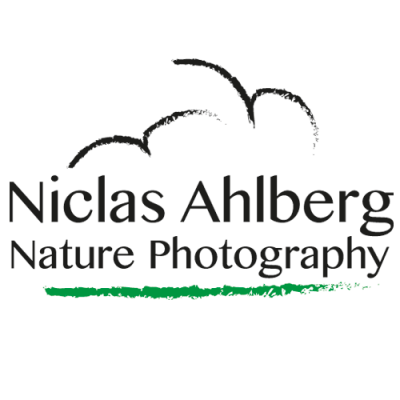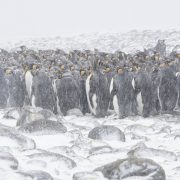With elephantseals and penguins in the path of Ernest Shackleton
After about 14 hours flight from London to Santiago, (firing of a years quota of CO2), it was really nice to see that the bags were on the same plane as me. The flight to Falklands is only once a week and if You don´t get your bags well, sucks to be You… The baggage will not catch up with You. So there is a huge relief and a lot of tension that disappears when checking in to Holiday Inn at Santiago airport.
The relief turned out to be short. When I 0430 find out that the flight was cancelled due to bad weather, the stress came back. After discussions with Latam we went in to Santiago for a sightseeing instead. We took a walk up Cerro San Cristóbal 818 meters above sealevel. I got a couple of lifers on the walk up. Unfortunately a nice English couple got robbed of their goldchains. It was not the end of their misfortune rather the start…. Back to the hotel and an early night.
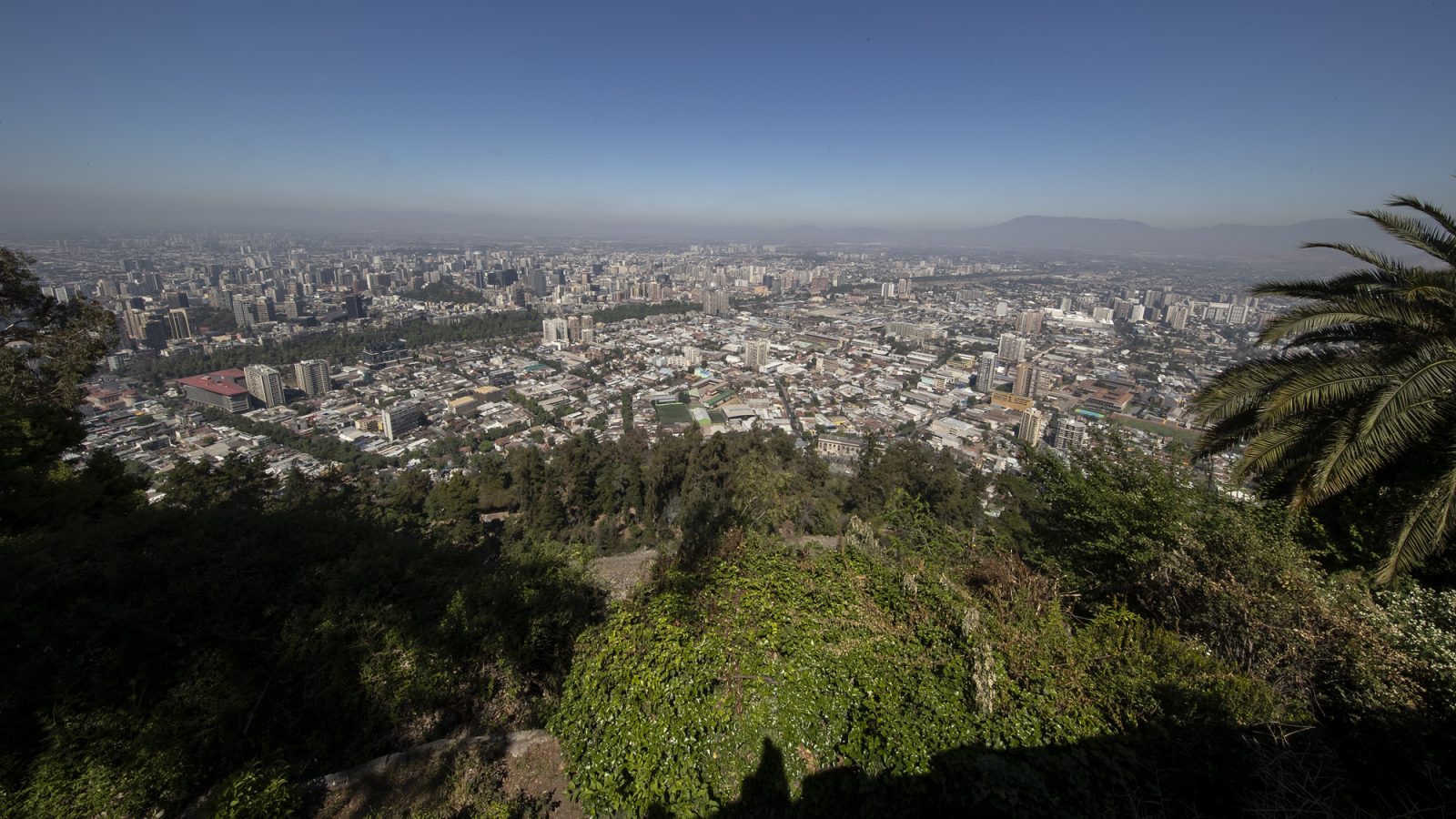
The view from Cerro San Cristóbal, a hill 880 meters above sealevel giving a vast view over the gigantic city Santiago.
I wake up and see the alarm on 0400!! Panic!! I know people were talking about daylight savings time in the evening. A quick look att the cellphone and it shows 0300. I make myself ready in 5 minutes and rush down to the reception just to find out that it is 0305. Puh… probably the cleaningstaff accidently? managed to change the time on the alarm. I go up to the room and take a long shower. At the airport I check my bags and head on to security. The securityman tells me I have to check my handle to the polecam. I have to go back to the checkin, get som plastic to wrap it and pray to God that it wont break. I got a little excited…but it all worked out. A strong coffee and a sugary donut gives me my balance back and my nerves slowly gets back to the inside of my body again.
Everything works fine and we are off to Punta Arenas, a small city where a lot of expeditions starts. Even though we checked our bags to Falklands we have to collect and recheck it and go through security again. The plane is two hours late but finally we are off. After an hour and a halfs flying we see the Falklandislands underneath. We made it. The pilot makes a weird turn and in the same moment I hear the pilot say in Spanish that they have to turn back because of heavy winds. My spanish is not perfect so I hope I was wrong but the message was just as bad in english. It is a surrealistic moment. We are turning back to Punta Arenas. I been thinking that it couldn’t get worse but I been proven wrong several times already.
Latam will have another go tomorrow morning and got us all lodging and food. We went around Punta Arenas countryside passing different hotels. We were dopped off last but best maybe. We ended up in an estancia that was really cosy. We had a good meal with lamb and wine. We all were exhausted and fell asleep before the head reached the pillow. Three days have already past since I left Stockholm and I haven’t even touched the ground on Falklands yet. Crazy!!
I woke up early and had time for some birding. I got some new chilean species in the garden and on the nearby golfcoarse. Blackface ibism southern lapwing and a couple of passerines.
Back on the airport in Punta Arenas I check my bags and go through security again. The staff recognise us from yesterday and greets us. It is becoming a habit to check bags and going through security. The flight is announced to depart on time and it is. Finally we land on the Falklands and rarely have I been som happy after a landing. My trip started in Sweden thursday 1800 and I land lunchtime monday. Not a good start. Let’s hope that the luck turns. We are guided by a funny guy that looks a lot like santa and he tells us everything about the Falklands. A place that would be very nice to visit again. The Falklands still belongs to Great Britain but has a national sovereignty. UK runs the foreign policy and military. There is approximately 3200 souls living on the islands and most of them live in Stanley. We go straight to the ship where we are guided to our cabins. We get an introduction of the ship and we also have a full evacuation drill all the way into the lifeboats. We have an excelent dinner and I rush out to enjoy the birdlife in the stern of the boat. The adventure has finally begun.
The boatride is what many birders pay a lot of money to do. A pelagic for three days.

We leave the Falklands and the sun is setting giving the mountains the blue colours.

The Cape petrell is one of the prettiest species of seabirds that you encounter in these waters.
Jag spenderar det mesta av tiden på däck och studerar och fota fågellivet. Olika delar domineras av olika arter. Stundtals är det mest svartbrynad albatross och jättestormfåglar. Plötsligt är det Capepetreller och Vandringsalbatrosser. Andra arter vi ser är Wilsons stormpetrell, black bellied stormpetrel, kerguran petrell, atlantic petrell, blackchinned petrell, Antarctic prion mm.

A cape petrell below a wave. They are often close to the boat and flying deep down in the rifts.

A southern royal albatross with sunlit clouds in the background in the first sunset on board the ship on our way to the Southgeorgia adventure.

Antarctic prion is a small seabird also called whalebird. It often follows whales and feed on krill that the whale pushes up to the surface.
In the evening Ole-Jörgen shows picures from the previous week that he spent on the Falklands showing us that we were all idiots that didn’t join him. Fantastic pictures in amazing light.
In the morning of the third day we see land through the fog. Southgeorgia. Suddely we see greyheaded albatross and lightmantled sooty albatross that we didn’t see at sea. Suddenly we see a blow and a couple of humpbacks show up close to the boat. A large flock of antarctic prions follow the whales hoping for a feast of krill.

Den gråhuvade albatrossen är fantastiskt tjusig med sin brokiga näbb.

En knölval pressar upp krill till ytan till glädje för en flock Antarktiska valfåglar.
The firs landing is in Rosita Harbor. There is a beach in a fjord where there are primarly fur seals that we are to photograph. After we have seen pictures of bitten, swollen handsafter meetings. The furseals have occupied the beach and are full of testosteron. So far there are only males on the beach. In a couple of weeks there will also be females and the males will be much more aggressive. After a short week we have the first meeting with the endemic passering South georgia pipit. How it ended up on the island is not known.

Antartic fur seal not a 100% pleasureful meeting. They are aggressive and their bites often gives serious infections.

The brown skua is a common bird on the beaches of South Georgia.
We carefully follow Ole-Jörgen. He carries a skipole that he gently points in the direction of the furseals. It is all it takes to make them back off. The beach is surrounded by snowcapped mountains and slopes covered with tussock grass. It rains a lot and the sun is just a faint memory. We all struggle to keep the camera dry. On the beach there is also a couple of elephant seals and four king penguins are hanging together like they were disussing some interesting issue. A south georgia pintail pass med and lands in the tussock grass. Brown skuas lands in front of a bleeding male elephant seal as to diagnose him if he might be close to become food. They are powerful birds and not very afraid of humans or anything else for that matter.
It works pretty well even though we are 35 photographers that invade the beaches. It is harder to use the wideangles than the large lenses since it is harder to avoid yellow and orange jackets. 🙂 It is a first, short landing but some pictures are taken anyway. Me and Ole-Jörgen make a quick polecam session and tryc to get som material with the fur seals but I get absolutely nothing. I tried to fix the autofocus all night but I didn’t get it to work.
The early morning landing is cancelled due to heavy winds and rain. However, I didn’t go to bed again and just a short while later the light was nice and I went out on deck. Suddenly there is a chicken on just a couple of feet away. That is the first impression when I see my first snowy sheathbill. An odd bird which looks a bit like the flightless birds from New Zealand. It even acts like a Kea when it tries to eat up the boat. It seems however a bit hard to digest.
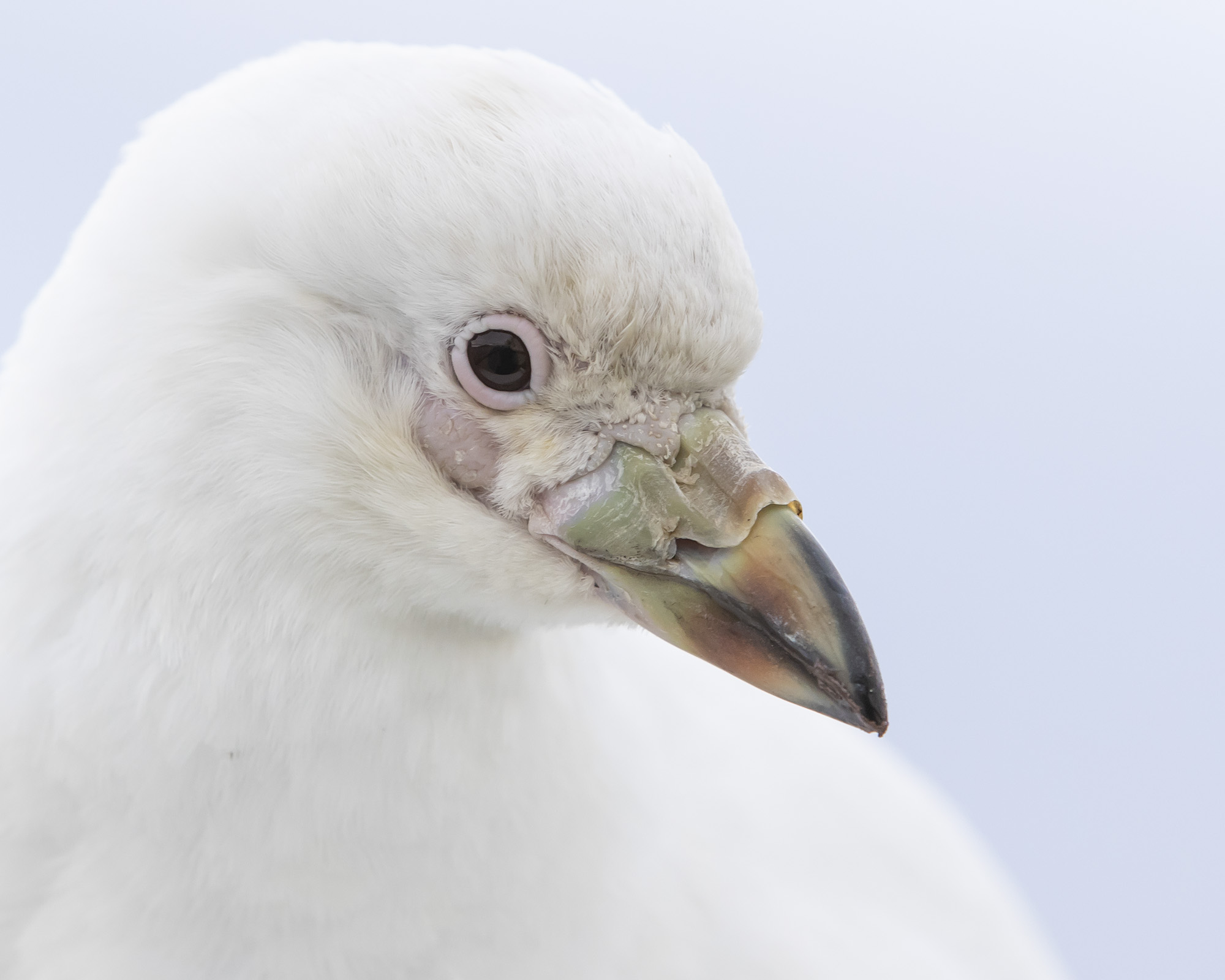
Snowy sheathbill, a bird that eat almost everything. Eggs, chicks, animal feces and boats.
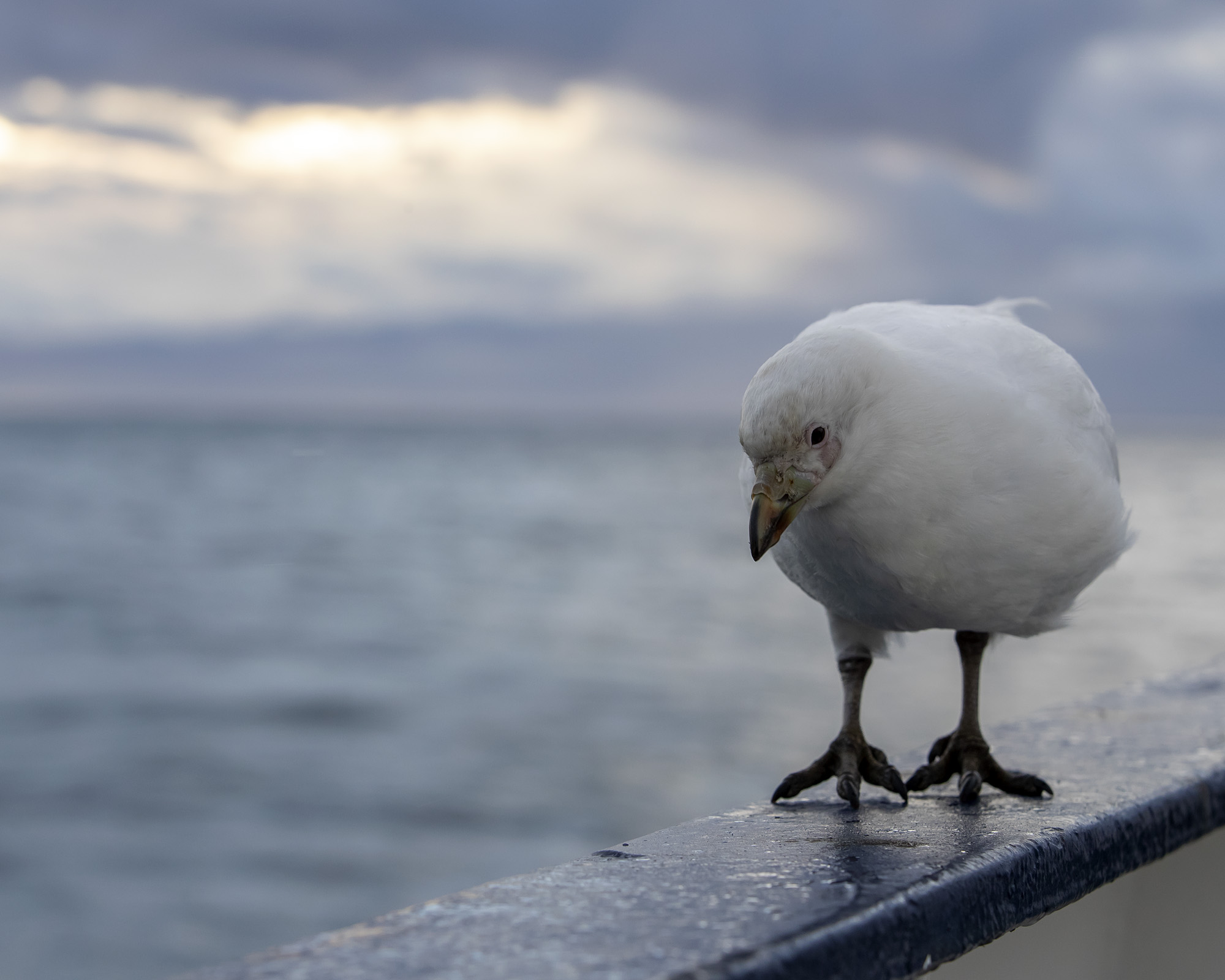
Usually we find them walking on land. They only fly when in danger or migrate and when in flight they look like pigeons.
A quick breakfast and then we jump in the zodiaks. The target for the first landing is Gold Harbor. A fantastic place with one of the lagest colonies fo elephant seal. It is a cool feeling to get of the zodiak between two gigant elephantsealbulls waying around 3,5 tons each. Apart from elephantseals there are plenty of king penguins, som gentoos, brown skuasm snowy sheathbill and some other species.

The king penguin chicks are not as cute as the chicks of emperor penguins but look fluffy in their brown suits.
I start with the polecam trying to get some pictures of the kingpenguins in the river. It is really hard because You need to get really close. They are not moving and holds their distance from me. I am not allowed to go closer than 5 meters. You really need a bit of luck to get them close enough for some interesting fotage. Preferably within a meter or so. You also need the water to be deep enough. The creek is unfortunately very shallow. They come a bit closer but stop again. I give up and try to get some other pictures instead. I change linses and try to get a variety of pictures and try to get som portraits and landscape pictures as well. I crawl around in the sand and the penguin poop and manage to get some decent pictures. I find it hard to isolate some individuals when it is som many penguins.

A flock of king penguins in a creek with rocks covered with tussock grass.
A great benefit with this beach compared to the other is that there are almost no fur seals on this one. This beach belongs to the elphant seals.
Gold Harbour is surrounded by slopes covered of tussock grass. A glacier is pouring down over a mountainside and fullfills the scenery on this fantastic garden of Eden. I hope that it will stay like this forever. Actually things have improved to the better here. But of course the changes are improving from the disturbance of man.
Both the rats and the reindeers that was brought by Norweigan whalers have been exterminated. And amazingly fast several species have recovered.

I see a brown skua washing up in the creek. I have the wind in my back and forsee that there is a good chans that it will take off straight towards me. I lay down and in a cpouple of minutes it flies straight to me.
I have to interupt the session and go back to the boat because of cameratrouble. I go back to the ship to dry up and take care of my equipment.
We raise the anchor and move on to Coopers Bay. A small beach where the only macaroni penguin colony on Southgeorgia is situated. The downside is that the small beach is garded by grumpy, male fur seals who will not move at first. After a while the reluctantly back off and we ascend a steep path up a hill thorugh the snow. We are accompanied by a couple of gentoos who also breed up on the mountain. It is snowing heavily which is good for the drama in the pictures.
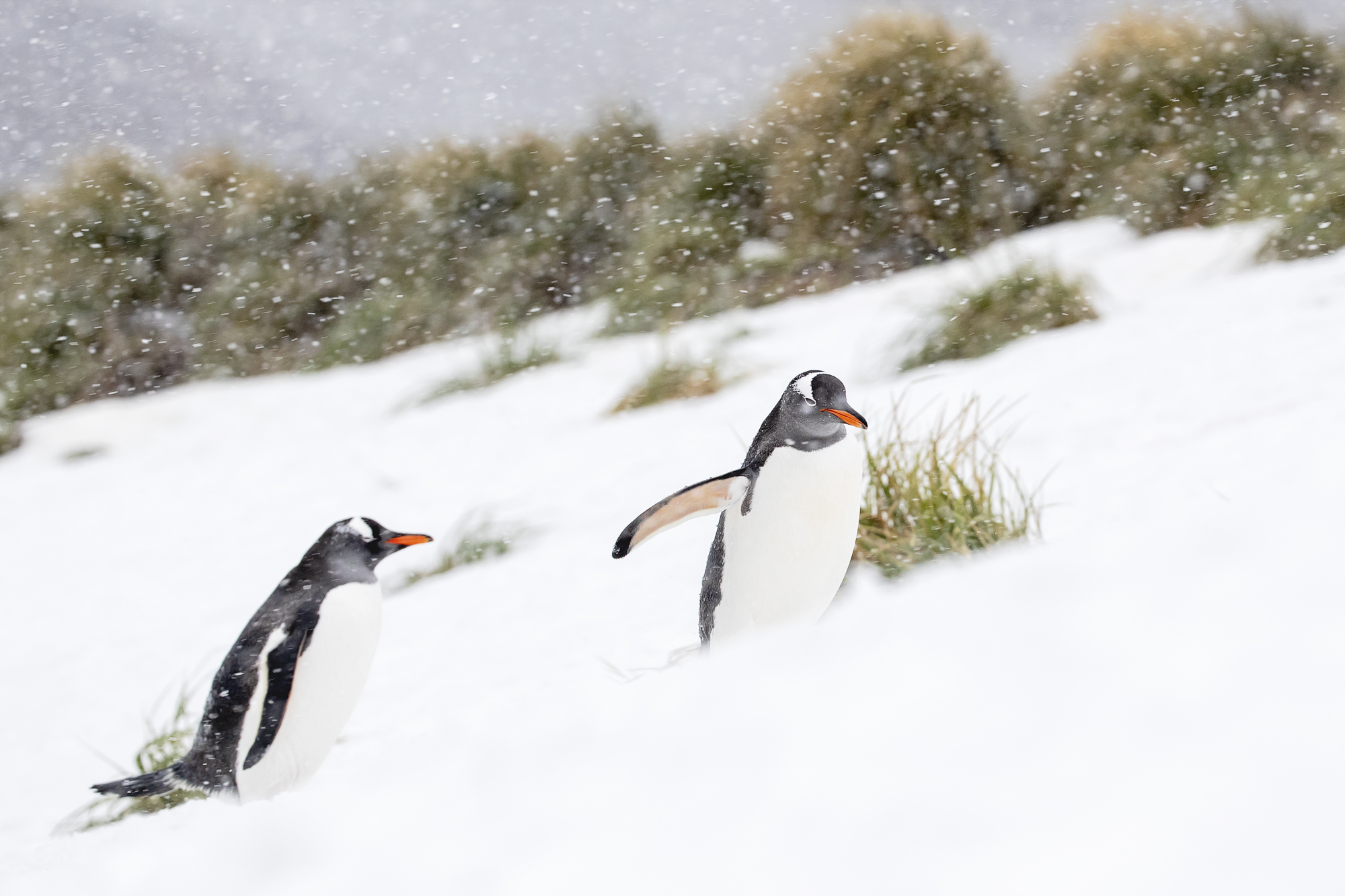
Two gentoos are struggling in the heavy snowfall and the steep slope.
Most of the photographers are standing in a group taking pictures of macaronis. I see a couple of lightmantled sooty abatrosses that are looking for a nice breeding spot. I get a couple of chances as they come wobbling in the wind. They are made for crusing among the waves not to do landings on small cramped spaces. It takes a couple of tries before it finally manages to land.
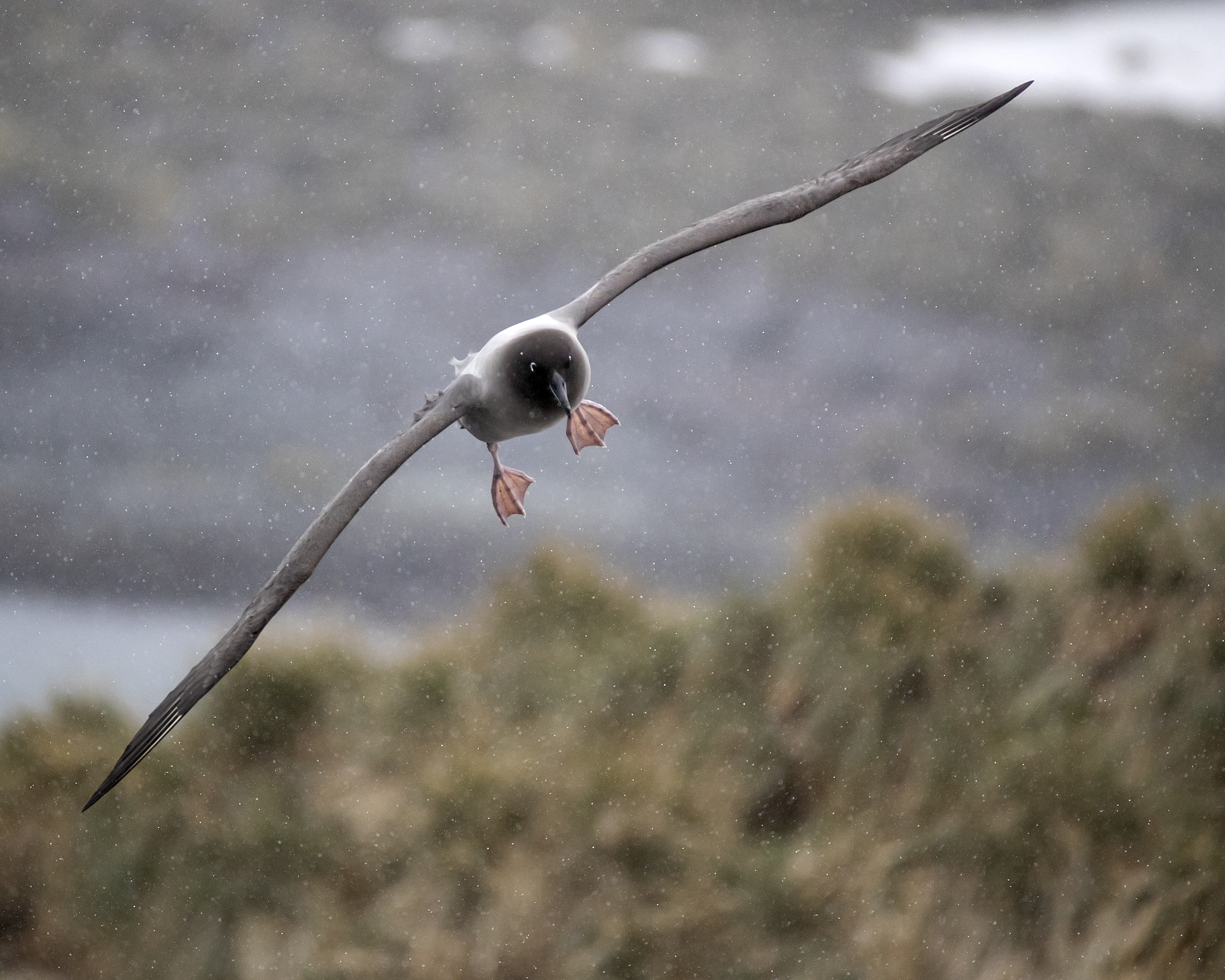
It is a wobbly and shaky descent in the wind and snowfall when the lightmantled sooty albatross is coming in for landing. It is really handsome in its caffe latte suit and white eyeshadow.

The macaroni penguin is the worlds most common penguin but is still redlisted because of its rapid decline in numbers.
I pass the group of photographers and climb higher up to get a better view of the colony. It was a good idea because now I see the wole macaroni colony. Ther are some birds flying below me. Among other species a southern giant petrel in white morph and finally a snowy petrell a species I really been hoping to see. I am for some reason attracted to completely white birds. Maybe it is the innocent appearance. Suddenly the wind picks up really fast and we all have to rush down to the boat to get back to the ship. It is a wet ride and a rocky climb up the gangway in the gailwinds.

The snowy petrel vas a dream species before I went to Southgeorgia. I saw it briefly a couple of times and this was the best image I managed to get.
The first landing today is at Ocean Harbour. It is an old whaling station. The place is mostly recognised because of the wreck on one side of the bay. It has been there since the 20ies. There is also a cabin and some lefovers from whales. Beach is guarded by furseals and a group of elephant seals. The furseals really stink. I haven’t figured out if it is because they urinate to mark their territories or if it is bad breath or maybe some gland that excerts a cologne that attracts fur seal babes. Me and Ole takes the zodiak and the polecam but once again we strike zero.

This little creature is the subarctics cutest piece of life. It was first chasing its flipper and finally it embraced. I tried to smuggle it on board to bring it back to Sweden but unfortunately I got caught….
There is an old burial site where to gentoo penguins pose in front of the crosses.
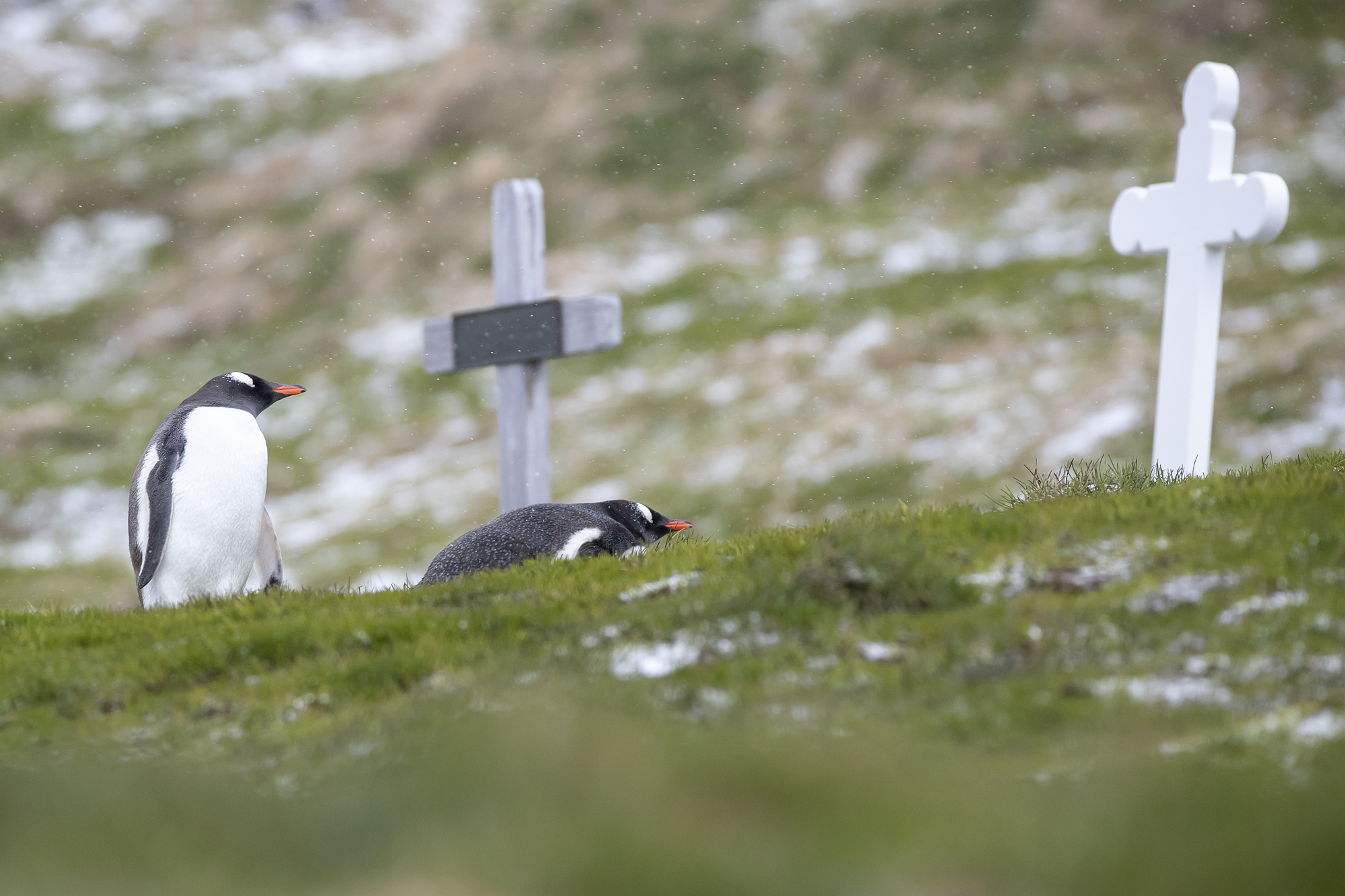
Two gentoos grief their diseased friend. Maybe he became a victim of climate change or a snack for a leopardseal.

A male fur seal in a characteristic pose in front of the wreck in Ocean harbor.
When You are a big group of photographer there are people taking pictures of everything but one has to avoid to be influenced by what everyoneelse is doing and to focus on your own thing.

The dominating element in Ocean Harbor is without a doubt the ship that was stranded in the 20ies.

Traces of a dark history is spread out on the beach. Ocean harbor used to be a whaling station.
After lunch we go to St:Andrews Bay. We come a shore and even from a big distance You can see there is an incredebly large number of king penguins on a flat surface some hundred meters from the landing place. There are probably a couple of hundred thousand penguins.

Thousands of king penguins, elephant seals, snowcapped mountains with glaciers. That is South georgia, a subarctic paradise.
The zodiaks slide up on the beach that is surrounded by high mountains. In front of the beach there is a wide valley. Most likely mad by a glacier. The glacier has retreated to the other side of a lake. From the lake there is a stream running down to the sea.
Most of the people move to the rookery where the mass of penguins are gathered. I decide to go up along a stream instead to avoid people. There are bif groups of penguins al along the river. Suddenly it starts to snow and the wind is picking up. There’s a white out coming. A wet dream for many photographers. The blizzard is like a filter that softens everything and makes more or less averything more atractive. You automatically get nice blurry forgrounds and backgrounds.

Groups of king penguins are gathered in tight groups and are probably enjoying the blizzard. Det är bara någon minusgrad så de tycker nog bara att det är skönt med lite svalka.
I am concentrating on a group of king penguins when a flock of South georgia pintails lands 30 meters away. I approach them and they start to walk in my direction. I just lay down and they walk past me in the blizzard. Personally I think the pictures from that meeting migt be the best. This never happens with ducks. They are normally jumpy and nervous. I am in a bubble just focusing on my photography. Happiness!
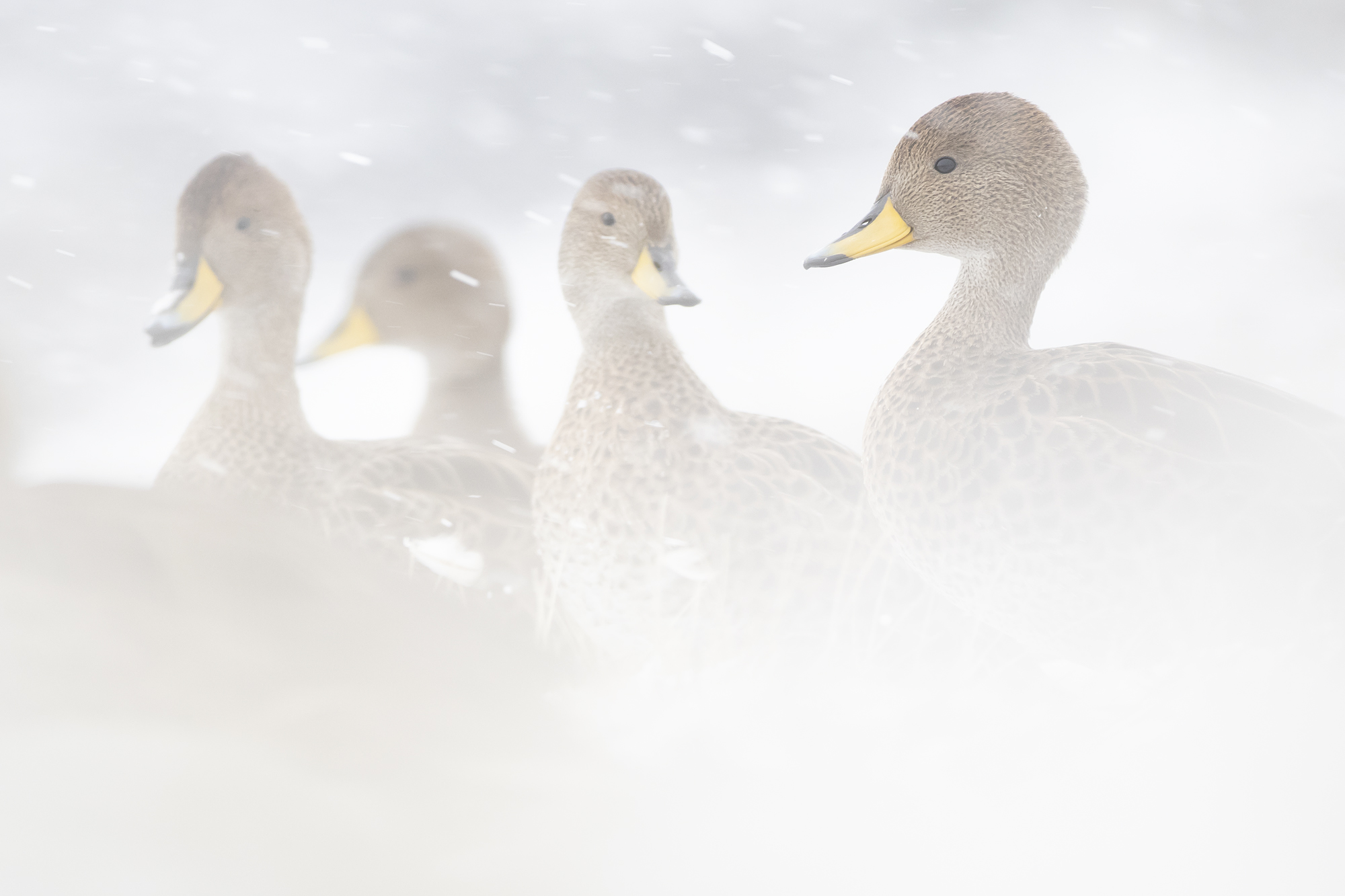
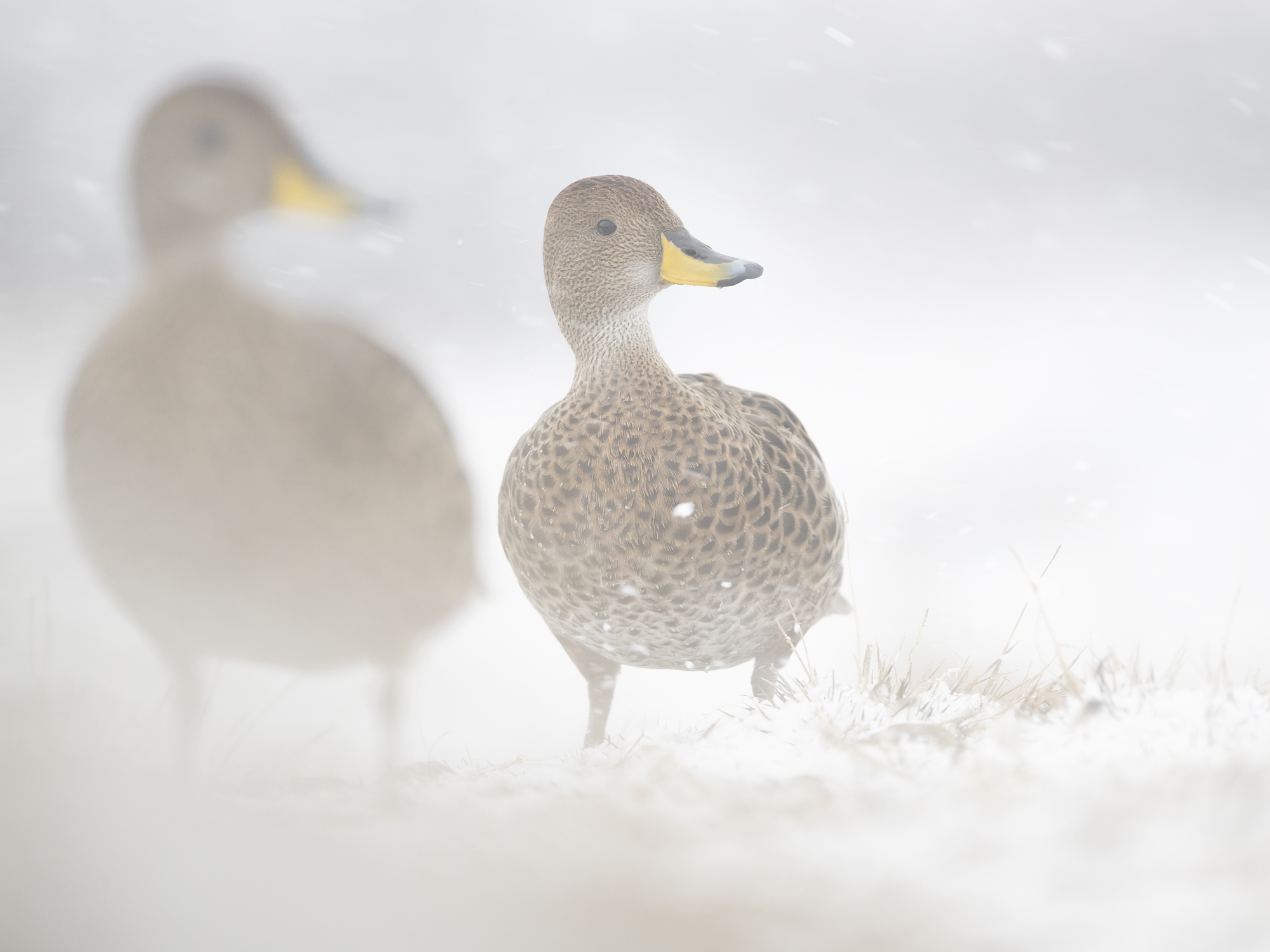
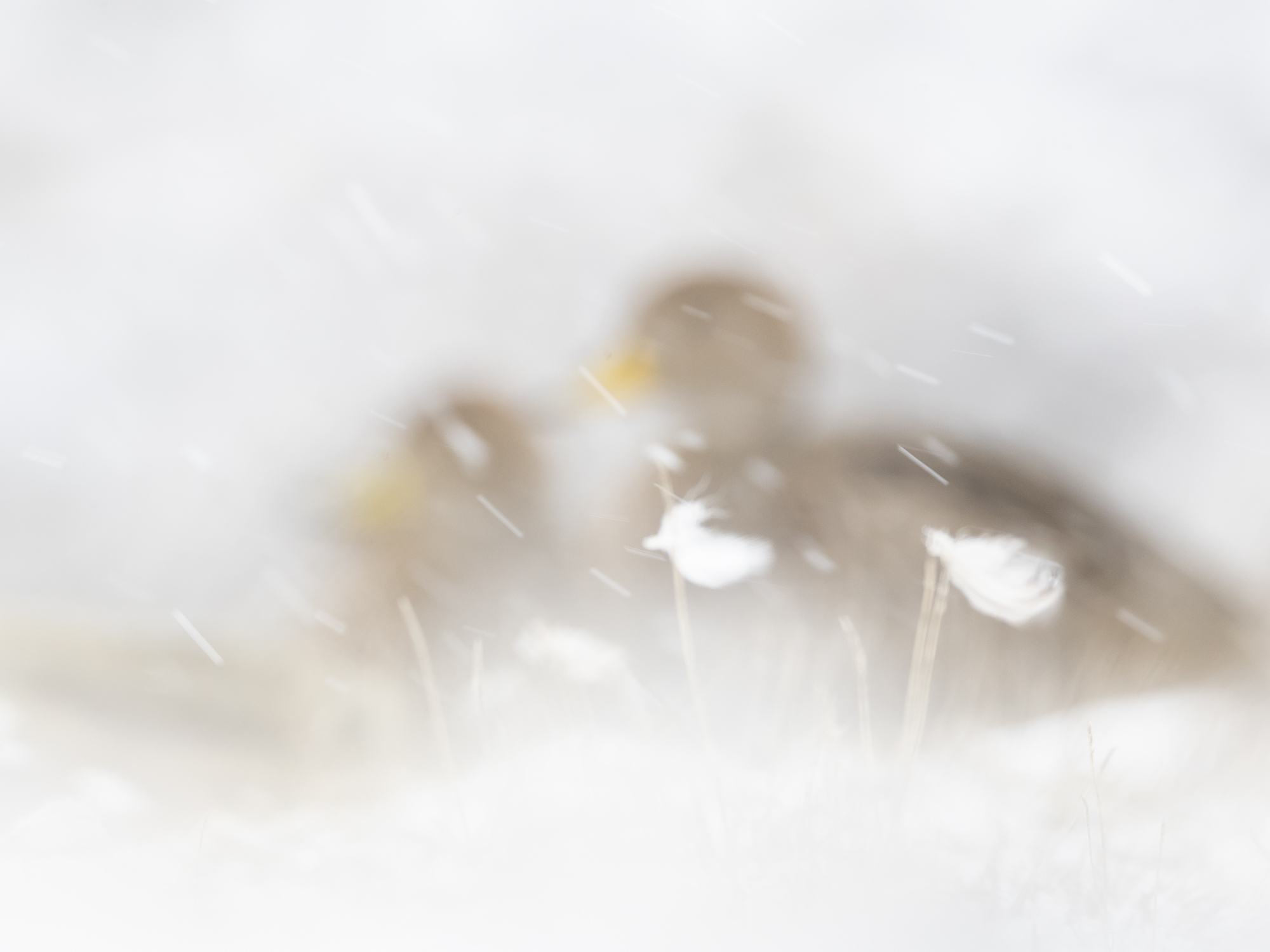
Suddenly when I look up I see two determined men in red jackets approaching. I recognize that tey are Christian and Peter. I immidiately get a feeling that I am late and that I missed the pickup time. When I tell them they just laugh and explains they were out for a walk so I have plenty of time. When we came a shore there was a female elephantseal that just delibverd a baby. When I come back to the shore there were two brown skuas eating of the baby. The mum dit some attempts to scare them away but the future didn’t look bright for the little one.



Two furseal pups are chasing eachother on the beach. A huge elephantseal shouts to them to take it easy. They just laugh and continue to play.
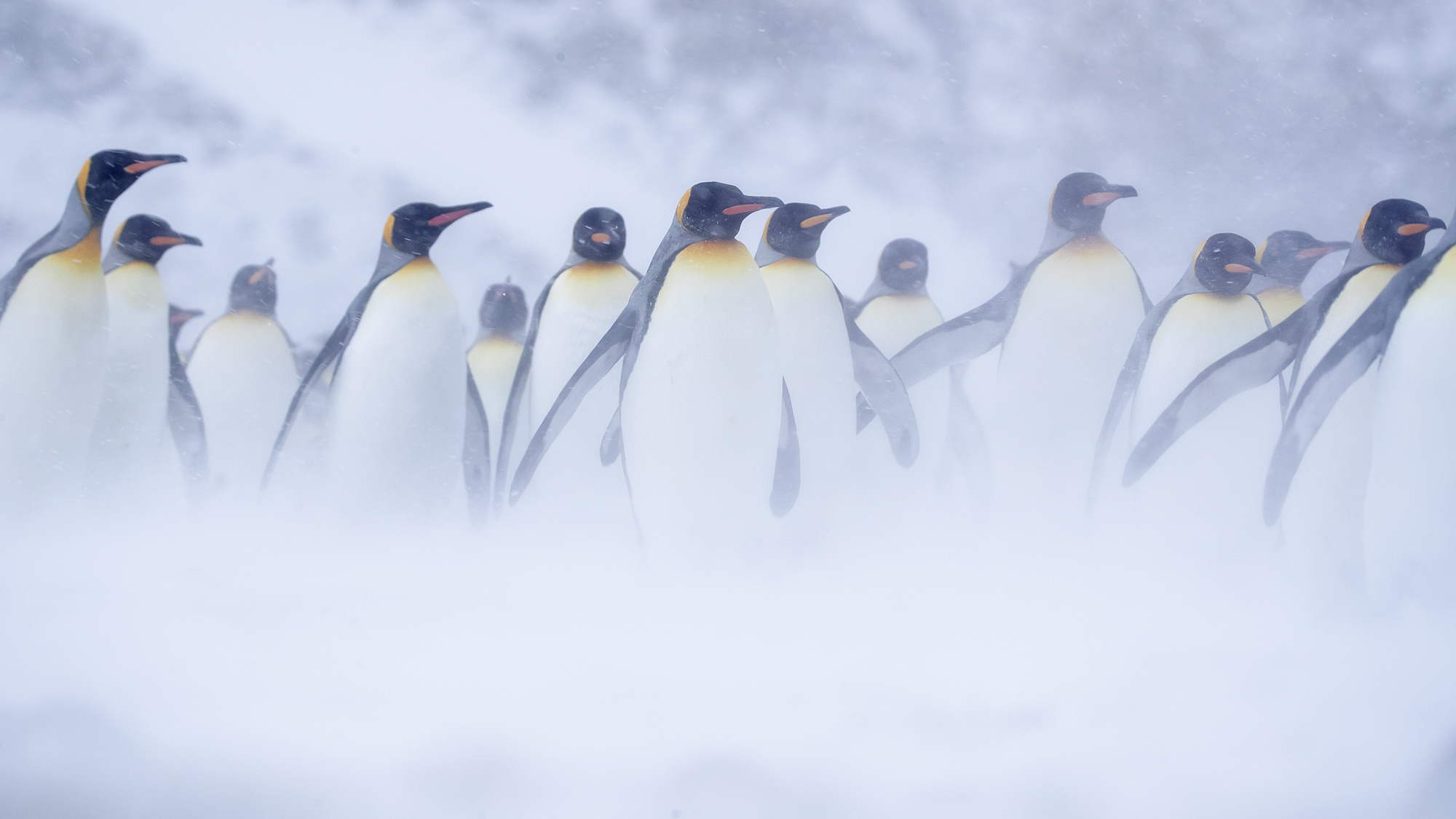
March of the penguins
During the night we have move to Grytviken. ”The capital” of South Georgia. This was where the whalers had their factory. Now there is a museum, a post office and also people that inspect all visitors to make sure that they are clean and do not bring any foregn seed or soil to South Georgia. Every morning before we enter the Zodiaks we wash our boots in different trays. And finally we wash them in a desinfecting fluid. When we get back from a landing the same procedure is repeated. The velcro on the jackets and trousers are magnets to seeds. I had to pick some seeds from Sweden away from the pants.

On Shackletons expedition there was an amazing photographer named Frank Hurley. He really managed to capture the drama on the expedition. And in the worst conditions with equipment that was sensitive to moist and temperature. I made this picture a bit older with a filter in PS to add som Hurley flavor to the image. Note the group of penguins that suddenly appeared as a perfect forgrount to my viewshot of Grytviken.
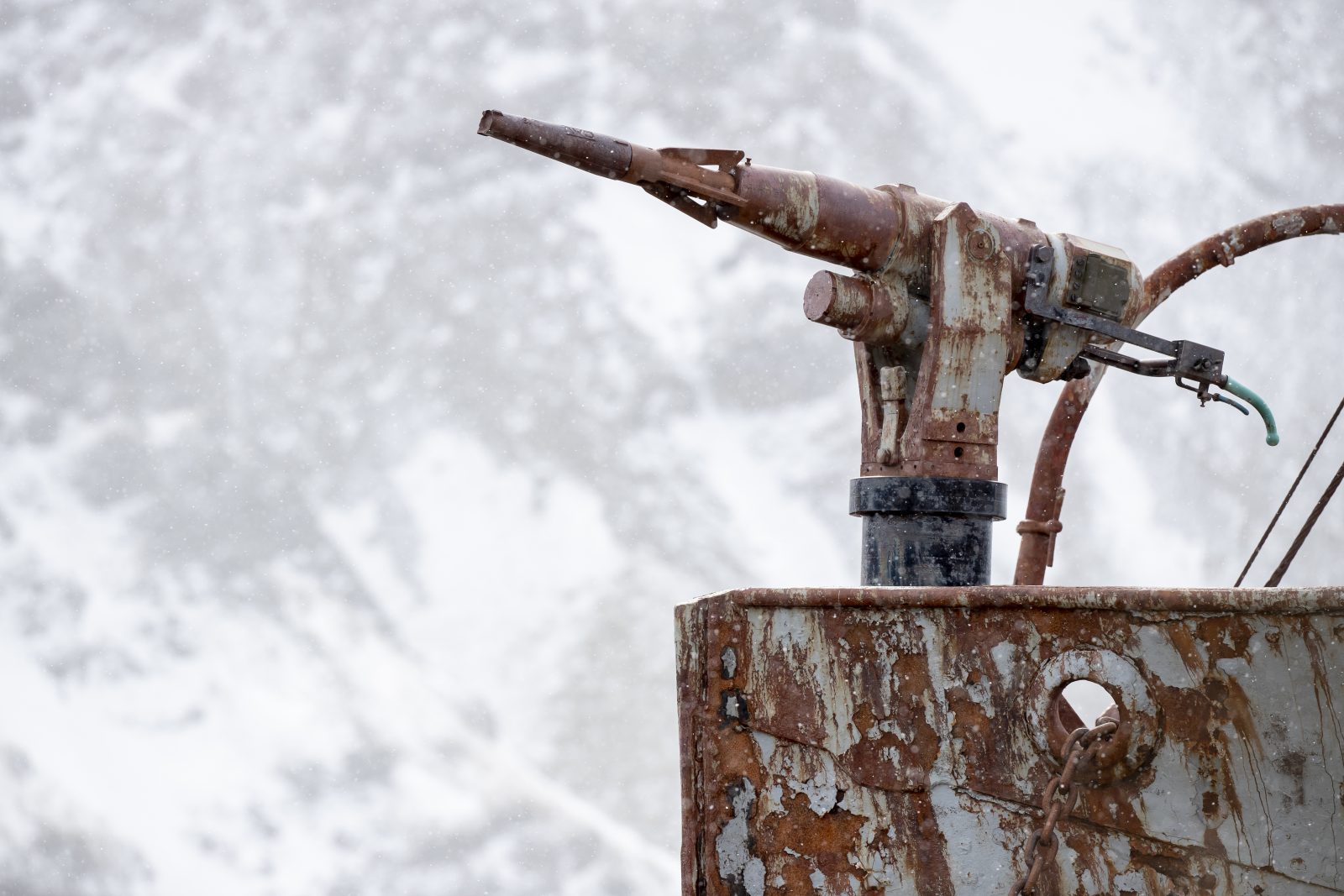
Approximately 30000 whales was killed during the use of the factory. Some species of whales have now slowly recovered. But others are still threatened.
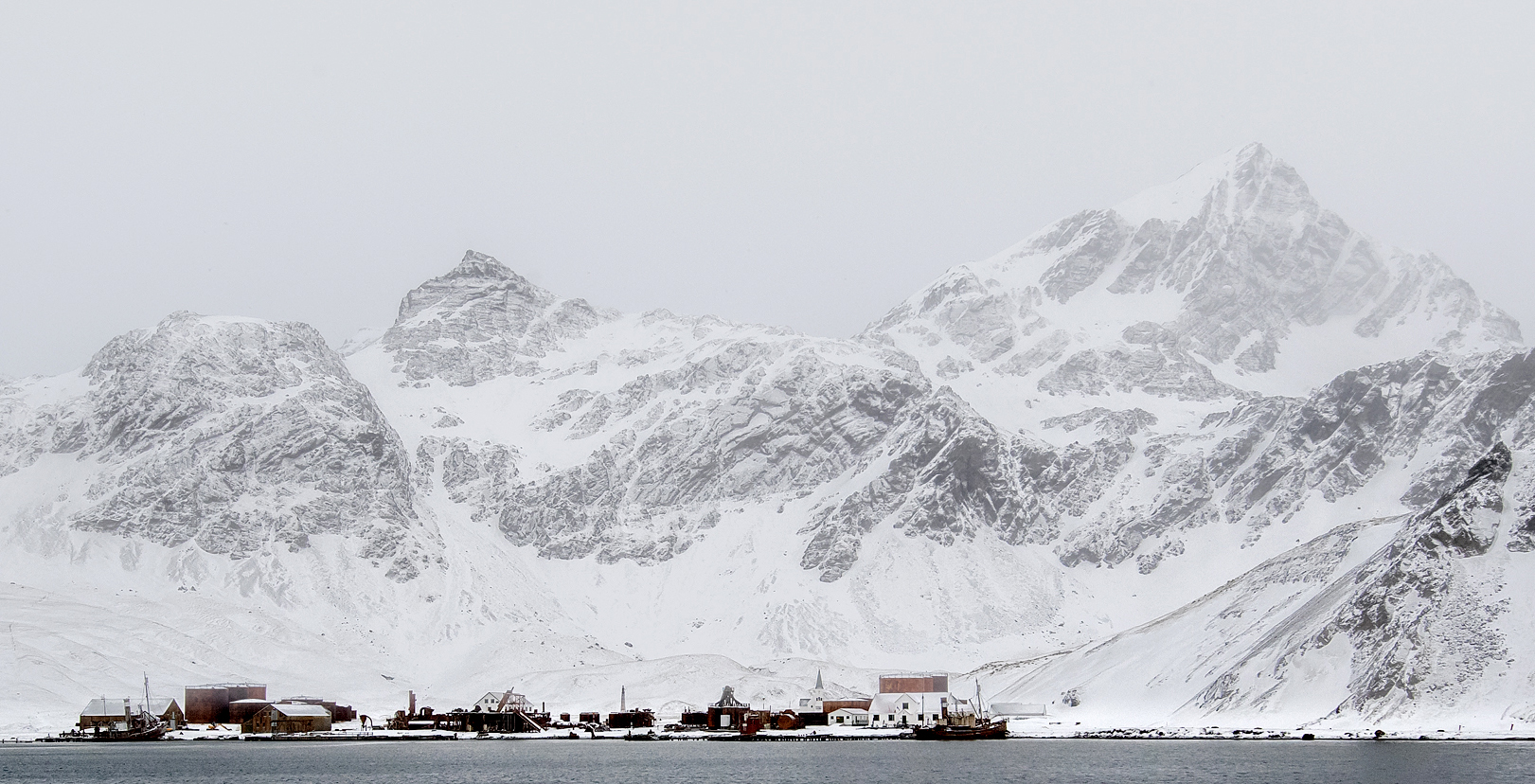
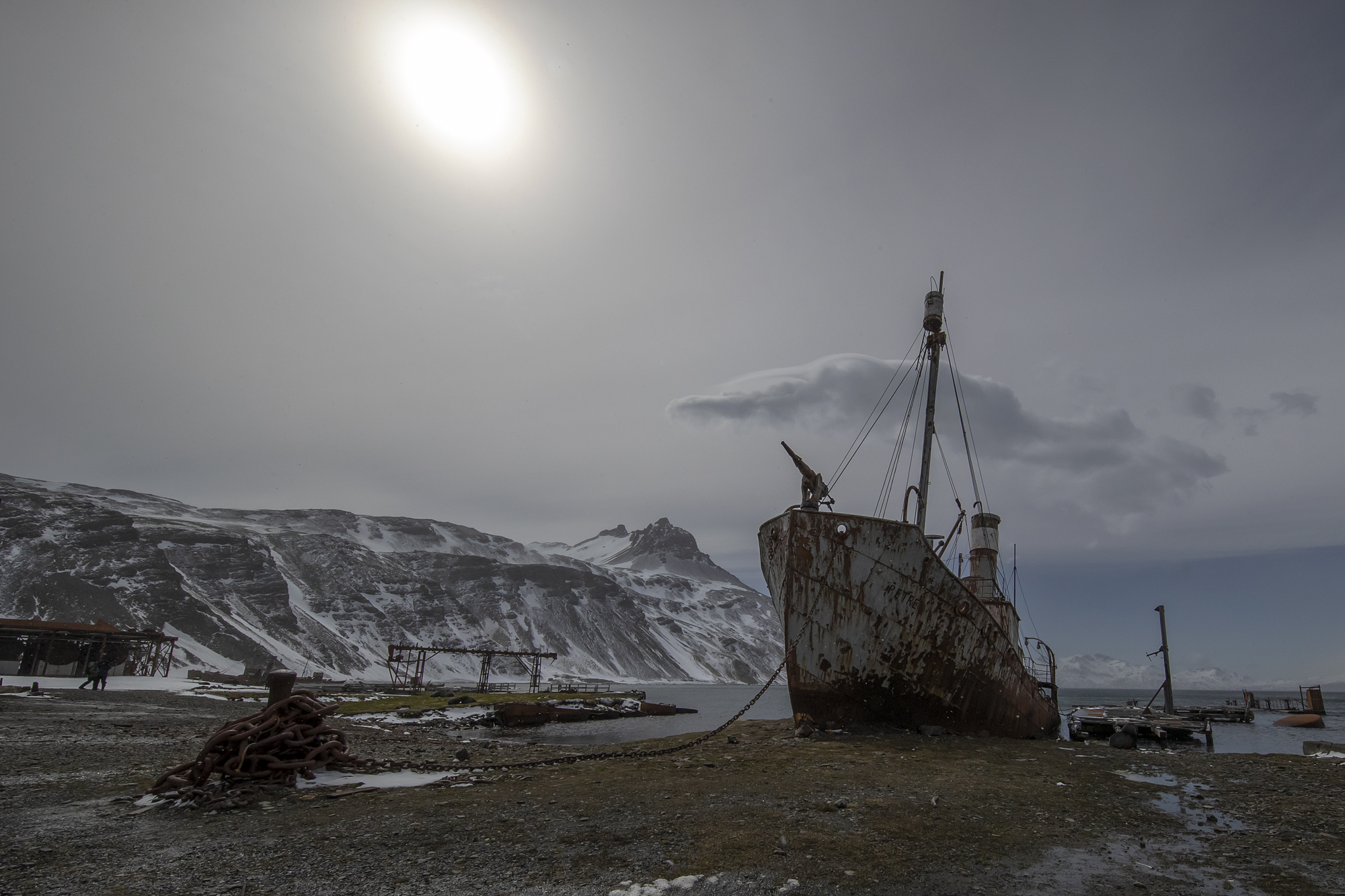

An antarctic tern is resting in front of the rusty tanks in Grytviken.
We managed the inspection perfectly to everyones joy and all could go ashore. It was excitiing to see nature reclaiming Grytviken. The factory is slowly but steady falling apart. You can see fur seals and elephant seals more or less in the factory. I visit Schackeltons grave and walk around the village.
On teh way to the grave I see two young elephant seals that are fighting. However You can see they really like each other because they never intend to hurt each other. It is more of a battle to see who is strongest. Maybe in the future they will be battling about the position as beastmaster. Tha battle will not be for fun. In the backgroound there is an old wreck. An antarctic tern is taking advantage of their fight and tajkes a fish that the sluggers have scared up.

Two young elephantseals wrestle in front of an old ship in Grytviken: The snow is drifting and You can see they are good friends and just fight for fun.

We finish up in Grytviken and get back to the ship for lunch. We are heading back to St: Andrews Bay which we all look forward to very much. The sky is breaking up and it might be a nice evening with good light. We land on shore by 17 but we are ordered back to the ship already by 1930. A decision I do not like. This was the only chance we had to a sunset with nice light. That is not the time to prioritize drinks and dinner instead of fantastic pictures. hmmpf….

It is a tough life in the subarctic region. You have to stay in shape…..
We are all a bit disappointed with the early ending of the evening landing. My plan was to go all the way to the rookery but I end up on the beach taking pictures of surfing penguins instead.
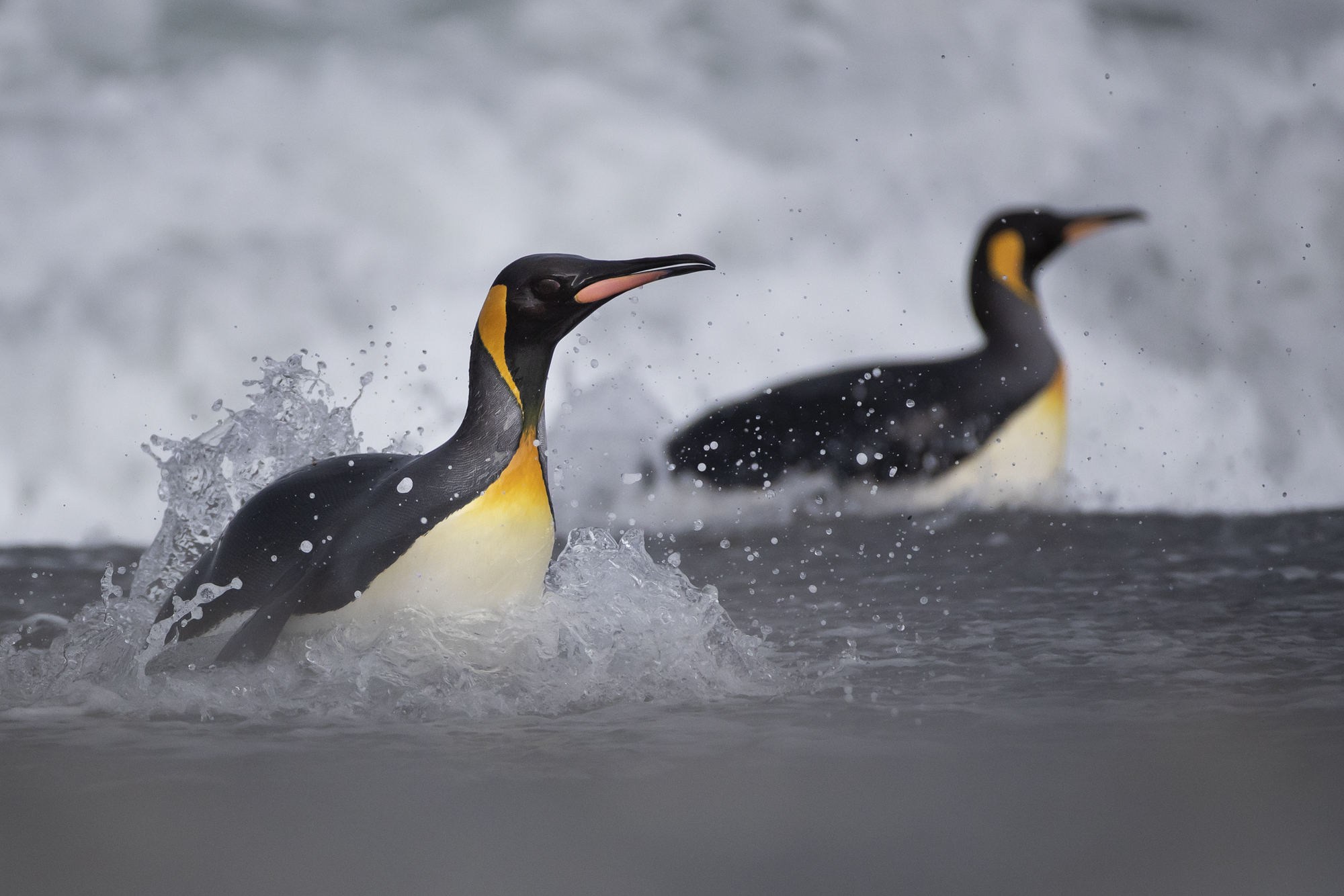
It is fun with splash and action when they surf to the beach. They are not so many a couple every ten minutes or so. The light gets better and better but they call us to the Zodiak and this is by far the biggest disappointment of the trip. I am the last person in the boat but there is still a couple of hours left of light. When I am on board they postpone dinner so people can have a drink in the bar. That´s a quarter of an hour theat I would rather have had on the beach.

It is lovely to have such fantastic models around You all the time.

My surf mates, kingpenguins
We raise anchor and head nort towards Salisbury plains and another nice site for king penguins. There is a lot of fur seals and elephant seals. Large groups of penguins are landing on the beach all the time so it is great possibilities to get action pictures. I try to get pictures under water with my polecam from the Zodiak but I get nothing under water. I get a couple of split shots that are decent. The water is to murky and full of bubbles unfortunately. This would have been the right place to go out in the zodiak to get pictures.

A King penguin is waiting for a good wave to surf up on the beach on Salisbury plains.
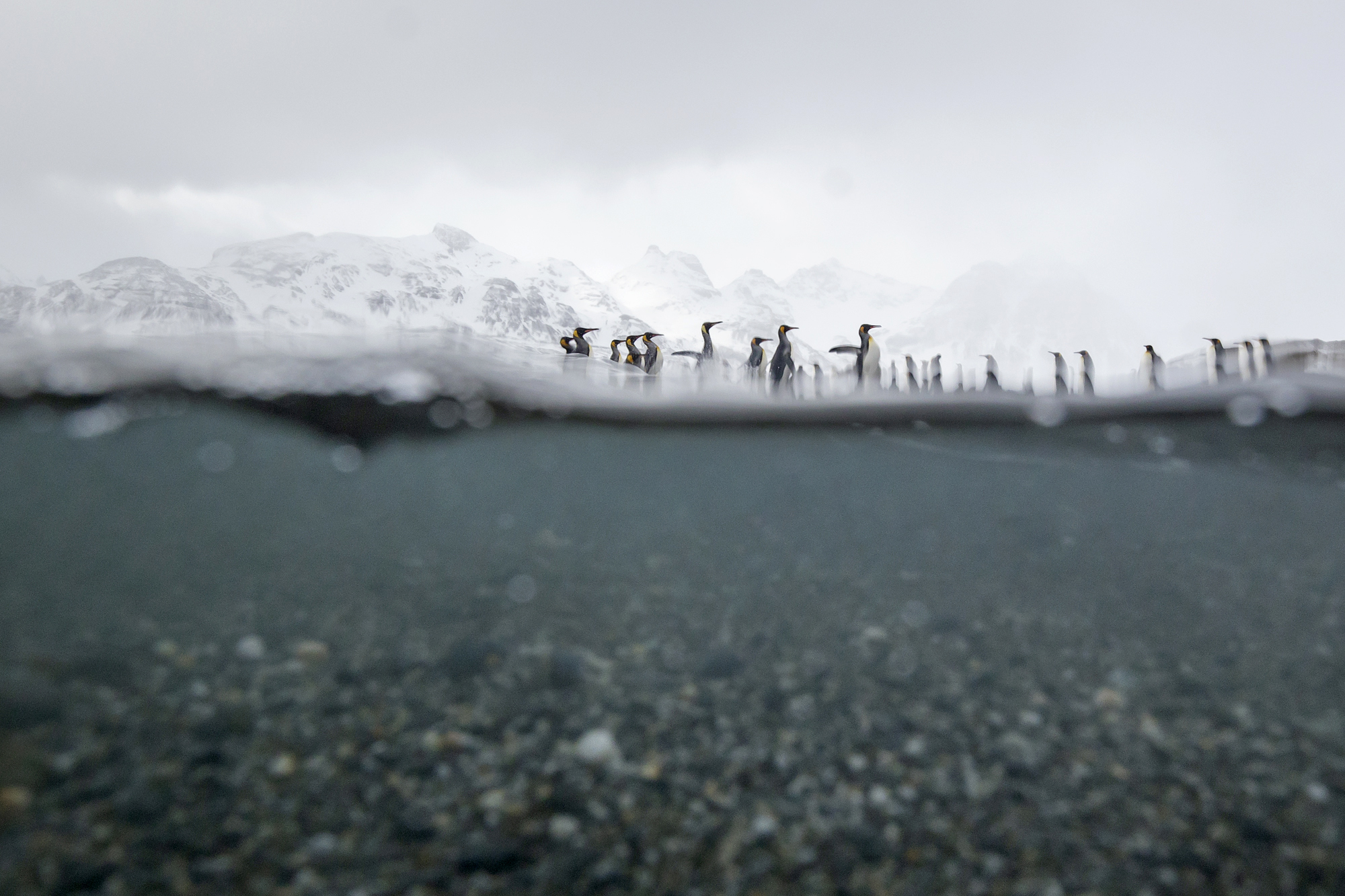
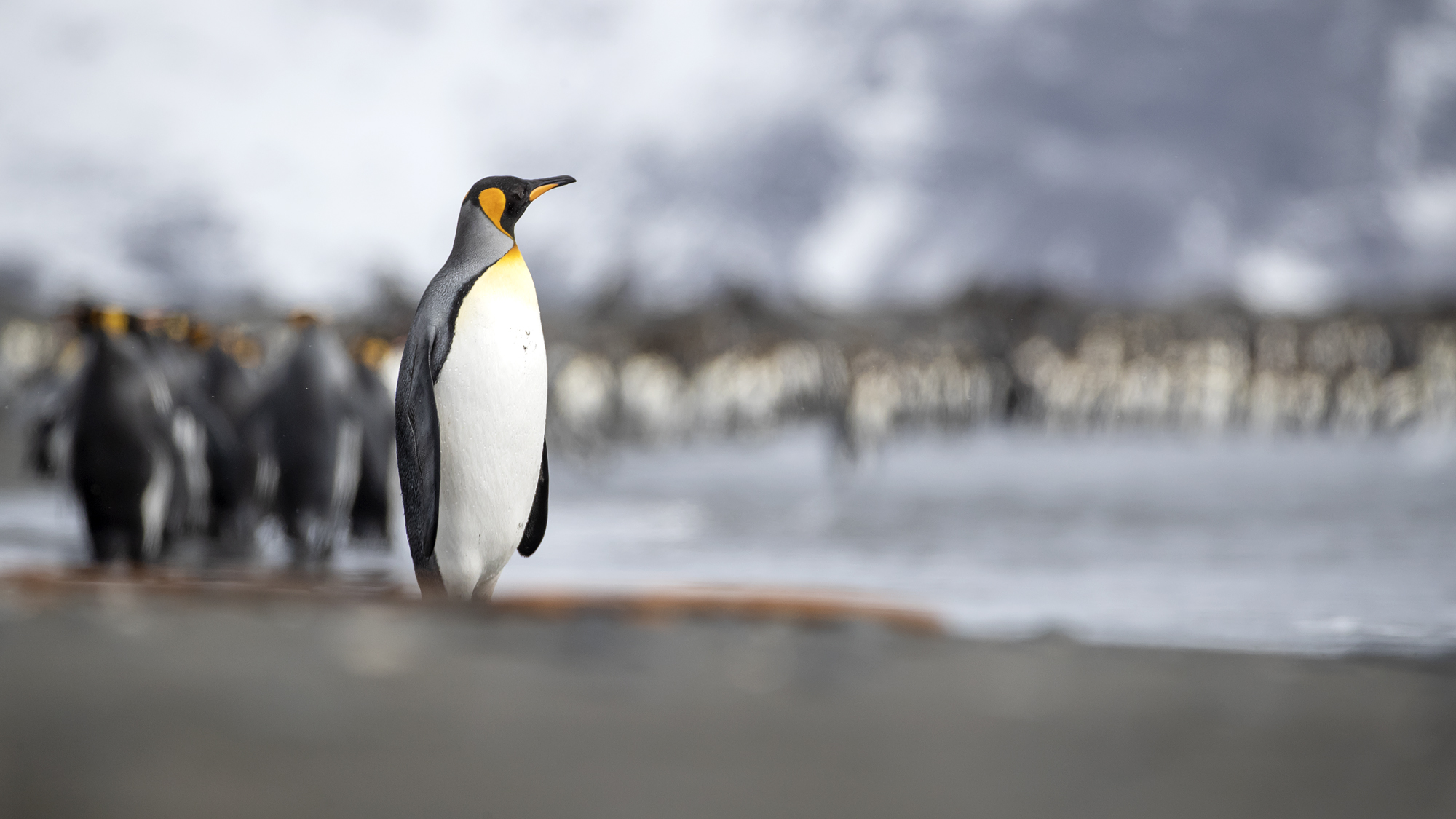
Suddenly something happens. A scream and then the expedition leader Martin tells us to immediately go to the zodiaks. Something has happened. It turns out that Richard has been attacked by an elephant seal. He has been bitten in both thighs. The details are not clear to me. Somehow the beachmaster has become aggressiv and Richard happened to be in the way. He was lucky. It could have been much worse. The guids put him on a strectcher and bring him aboard to the shipdoctor. He is being stitched up and put on antibiotics. Sealbites kan be very infectious.

Elephantseals rarely attack humans but they can be very protective over their harem of females. And sometimes You just might get in the way. They are animals and You can never entirely be sure how they react.

Elephant seals are a bit like dragons when they burp. Warm air is exhaled rapidly like smoke.
We have lunch and after that we go to Prion island where their are wandering albatrosses breeding. A tiny beach with a large number of furseals has to be passed before You come to a boardwalk that leads up the hill to the breeding site. There are alson gentoos breeding there and a group is just flushed up on the beach. It is not very much action. There is 2-3 chicks and no adult birds. It is raining and most of us are lacking the inspiration and we are all worried about Richard.

En vandringsalbatrossunge som väntar på att dunet ska lossna så den kan flyga ut till havs.
We get news about Richard and it seems to be stable however the risk for severe infections forces us to leave to the Falklands straight away cutting the trip on e day short. That is a decision that everyone supports since safety is always first. And as a bonus we might get a day on the Falklands for other species of birds.
Now we have three days on the ship for the crossing. Seabirds from the stern is on my program. Today november 13th it looks lite there might be a nice sunset.
The ship is rolling more since we go against the waves on the way back. Sometimes it gets a bit creepy when there is water above You on all sides. The next second you are flying high. Now and the a wave hits the deck but I have rubber boots so it is ok. I am hoping to get some pictures with birds and the waves in the background so you can feel it is rough weather. There is not many other people on the deck. There is quite a few people that are seasick in bed. We pass an iceberg which is amazing in the evening light. It is like mother of pearl and the dark skyes in the background makes it even more pretty. To complete the moment there is a chinstrap penguin on the iceberg. The only chinstrap that I have seen in my life. It is really cool with the small penguin on the big iceberg. I get a few shots that I really like.
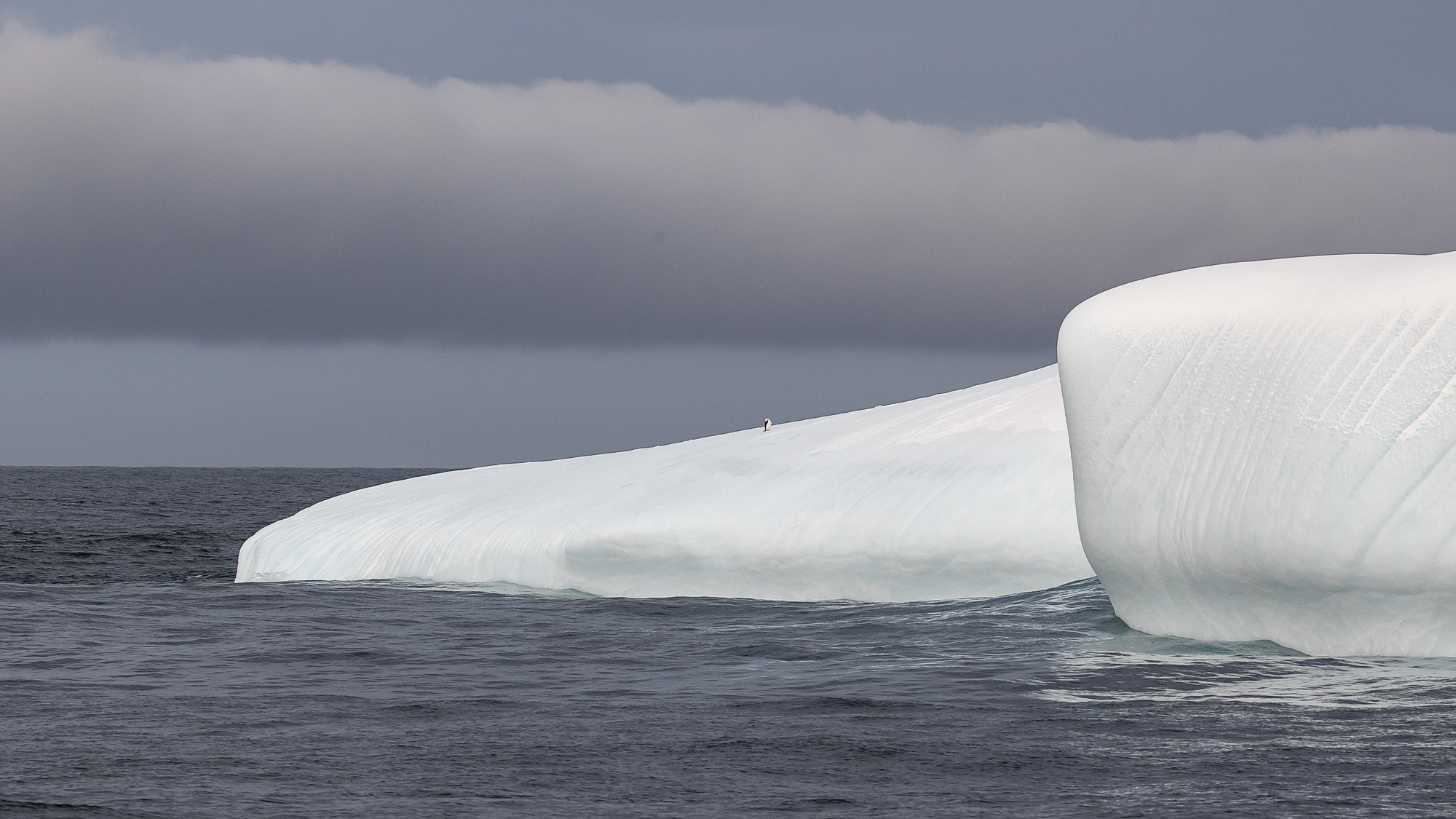
The chinstrap and his iceberg.
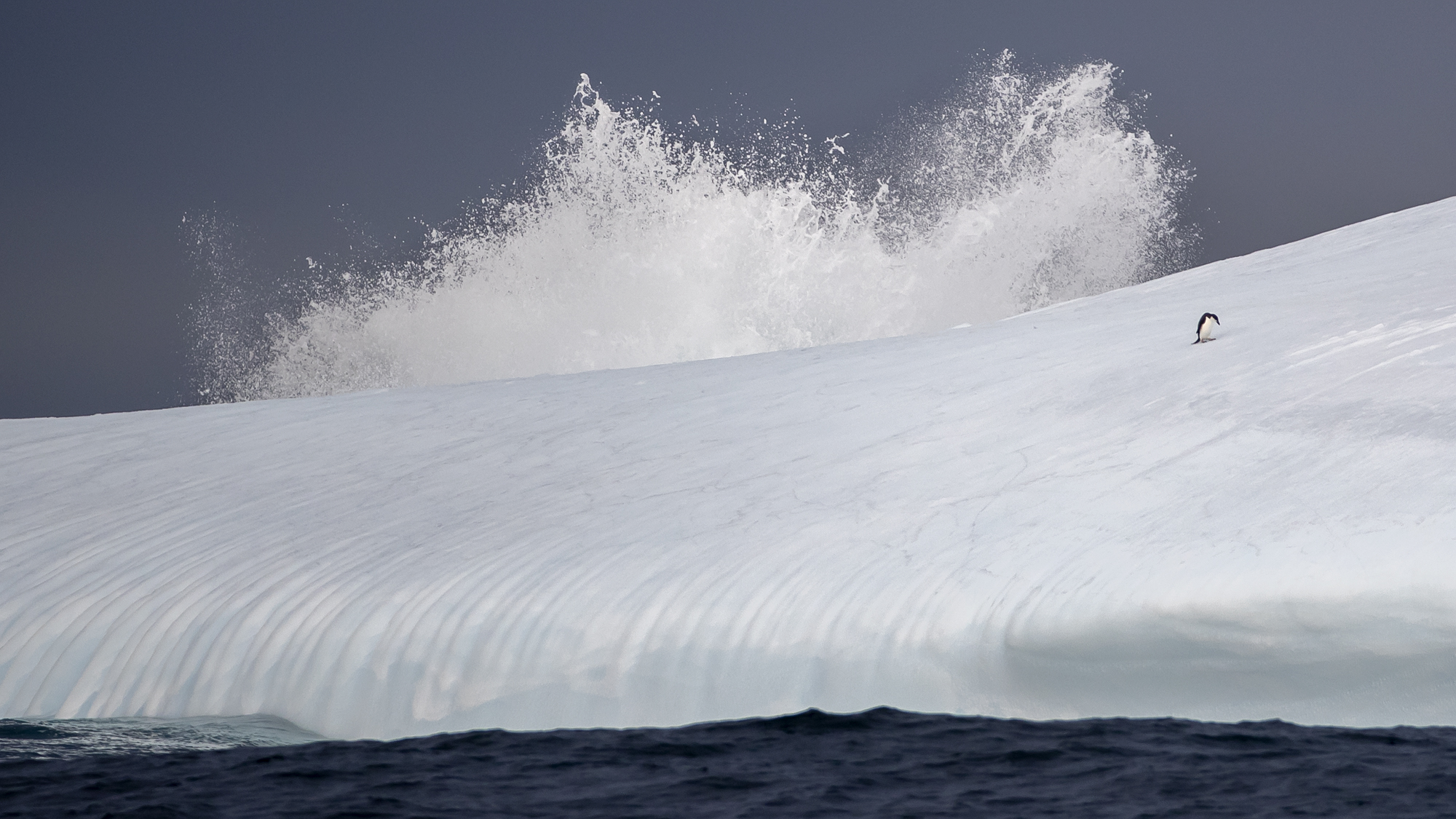
Sista dagen när vi närmar oss Falklandsöarna får vi sällskap av en stor grupp med Commersondelfiner. Det är härlig att se dem till synes utan ansträngning surfa fram i vågorna. De har stora ytor med vitt vilket gör det ganska lätt att se dem under vattenytan vilket gör det lättare att fota dem när de kommer upp för att andas. Hela gänget kommer ut och njuter av deras närvaro.
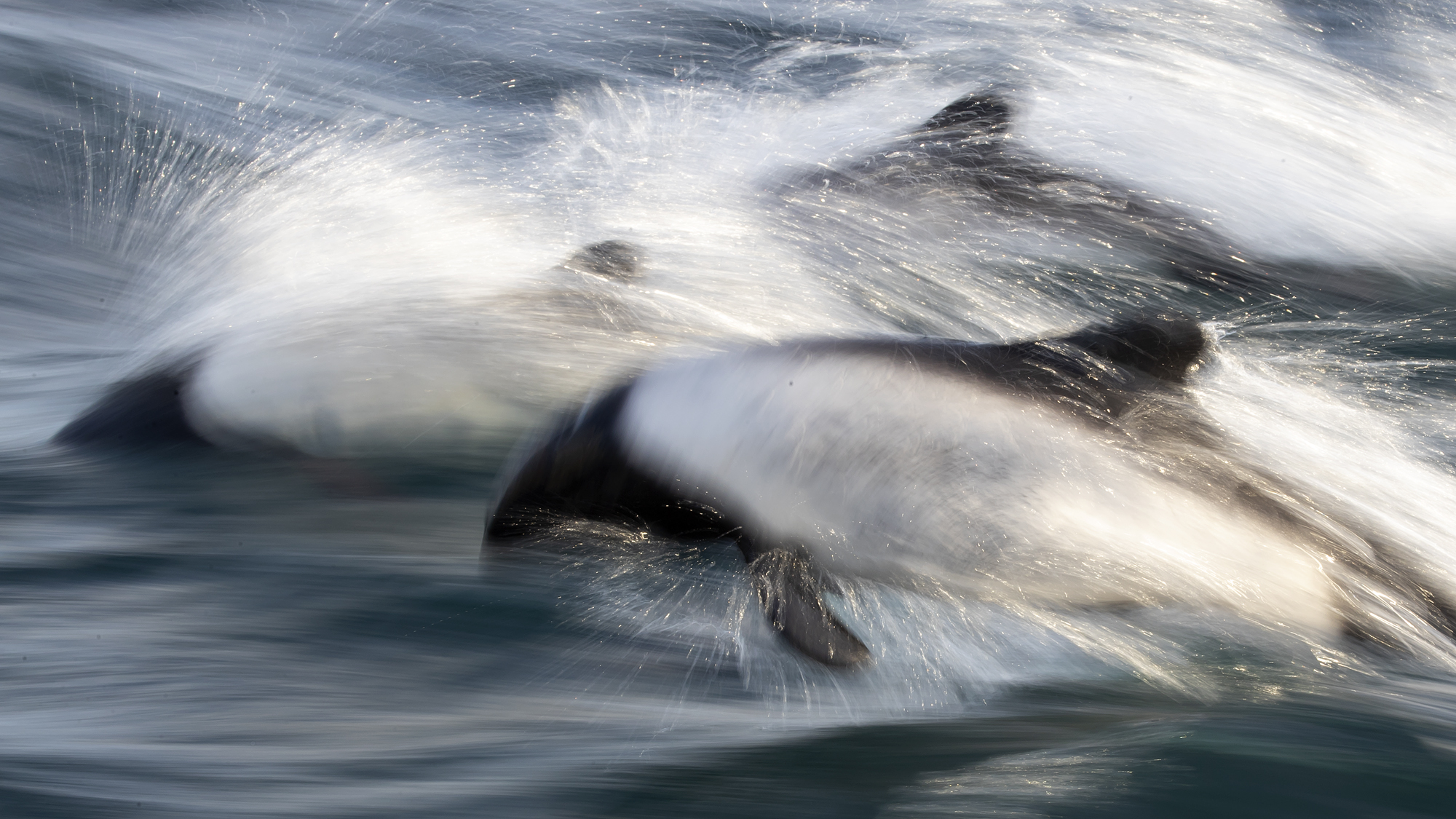
Commersons dolphin är en liten delfin. Den påminner om våra tumlare. Den kallas även skunkdelfin pga sin teckning.

We arrive Port Stanley on the Falklands late afternoon and are met by a boat that collects Richard. There are also some government officials that interviews the staff about the incident to learn from it and if possible avoid future accidents. After an hour we leave again. The extra day we got on the Falklands will be spent on West point which is the wersternmost island on the Falklands and among other things there is a big colony of blackbrowed albatrosses and rockhopper penguins. It is thirteen hours to west point so I rapidly calculate that there want be a sunrise shot tomorrow either.
We arrive West point around seven in the morning and the sun is already high on the sky. We land and get a lovely walk a couple of kilometers over a grasscovered hill. Different species of grass, small plants and lots of gorse bushes. Big bright yellow fields. It looks pretty but is appaerently more or less a weed that has spread rapidly in is very invasive on the islands.

There is a lot of birds in the sunset. Maybe a whale is eating krill in the surface to the birds delight.

Longtailed meadowlark
Because of the harsh light I see the trip mostly as a birding trip. However the sun is softened by some clouds so the light is not as harsh anymore. There are several new species to me. On the landing site there is a Rock comorant, Falkland flightless steamduck, patagonian crested duck and two different species of oystercatcher. On the way up the long hill I see a group of black-chinned siskin and the very cool species long-tailed meadowlark which has a scarlet breast and a beautiful song. It is easy to spot in the yellow gorse bush.

Scarlet on yellow. The yellow plant is Gorse importe from UK.
After fifteen minutes I arrive to the other side of the island where the blackbrows are breeding. The breeding site is beautiful. Steep cliffs with waves breaking underneath turning everything to white foam and the water is spraying high up in the air. The nests are improved year after year and the old ones are like high poles of clay and rise high in the tussock grass. In the middle of the colony there are also rockhoppers breeding. It is a really cool bird. If You haven’t seen the movie Happy Feet, you have to see it. The coolest bird in the movie is the rockhopper.

The two small white dots on the shelf above the water are two rockhoppers. An instant after this picture was taken one of them bounced via the rock down in the water. Kamikaze penguin is probably a more descriptive name for this tough bird.
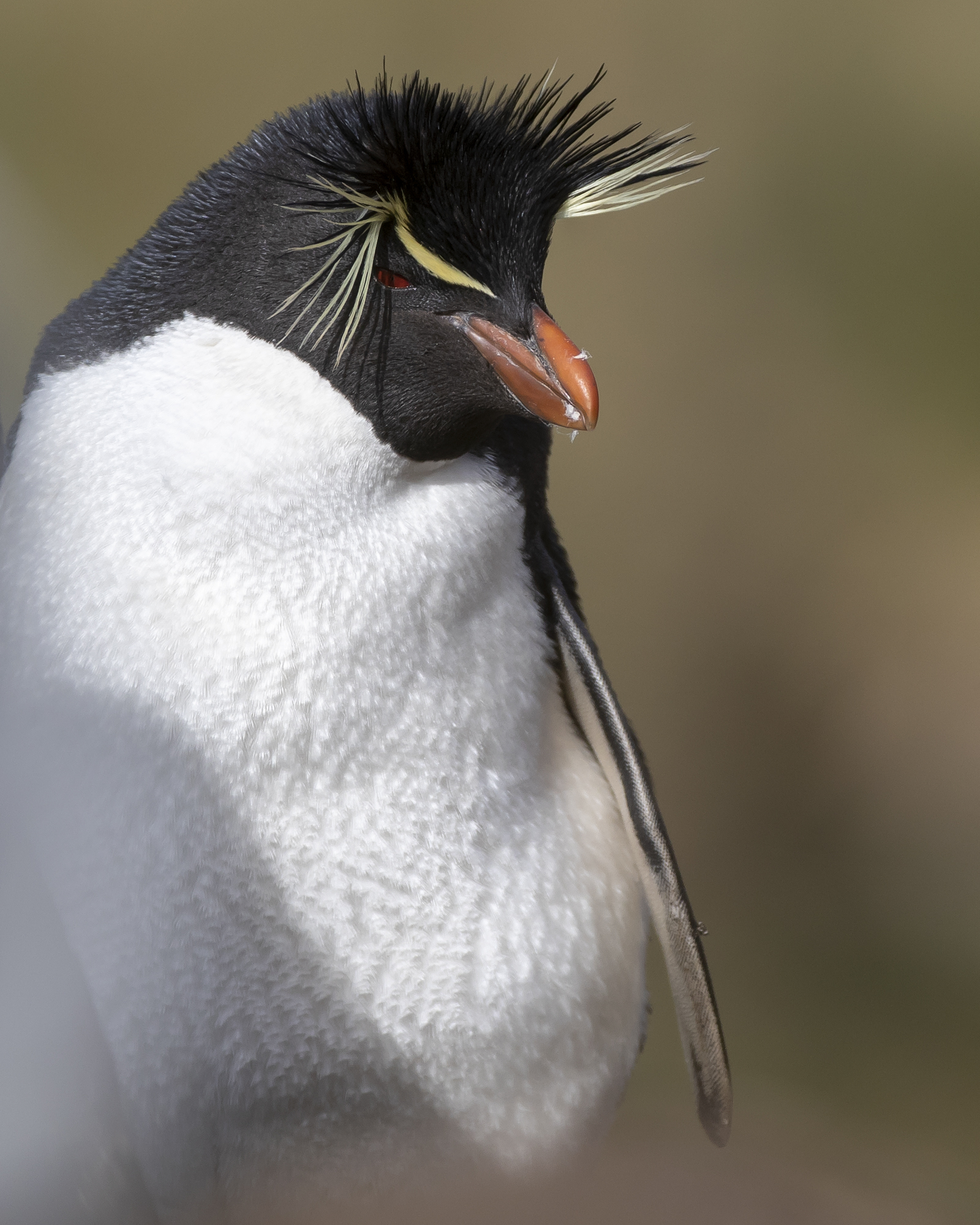
Northern rockhopper
The light is very harsh and I find it hard to find interesting motives but suddenly I see the blackbrows in front of the black cliff and get an idea to heavily underexpose the image so I do not burn out the highlights and also make the rock more black.

Blackbrowed albatross

Blackbrowed albatross
On my way from the colony I hear a nice tune of birdsong in the tussockgrass. It is a wren. I am hoping for the endemic species cobb wren but it turns out to be the more common sedge wren.

For a while I thought I found the endemic cobb wren but it turned out to be the more common sedge wren. A lifer either way 🙂
On the way up I see some ponds that I decide to visit on the way back. I am hoping for some waders or ducks. I find three yellow billed teals another lifer.

Yellowbilled teal
A turkey vulture sweeps buy very close.

A turkey vulture checks me out to see if I am tender…

Upland Goose
Down in the harbor I take a walk along the beach and photograph the pretty geese kelpgoose and upland goose.

Kelp Goose
Suddenly the geese are warning and a striated caracara snatch a chick right in front of the parents. It lands and eats it up in a couple of seconds.

Striated caracara
I lay down on the rocky beach and get lucky when two steamer ducks pass me very close. I take the last zodiak to the boat and the last frame is taken for this trip.
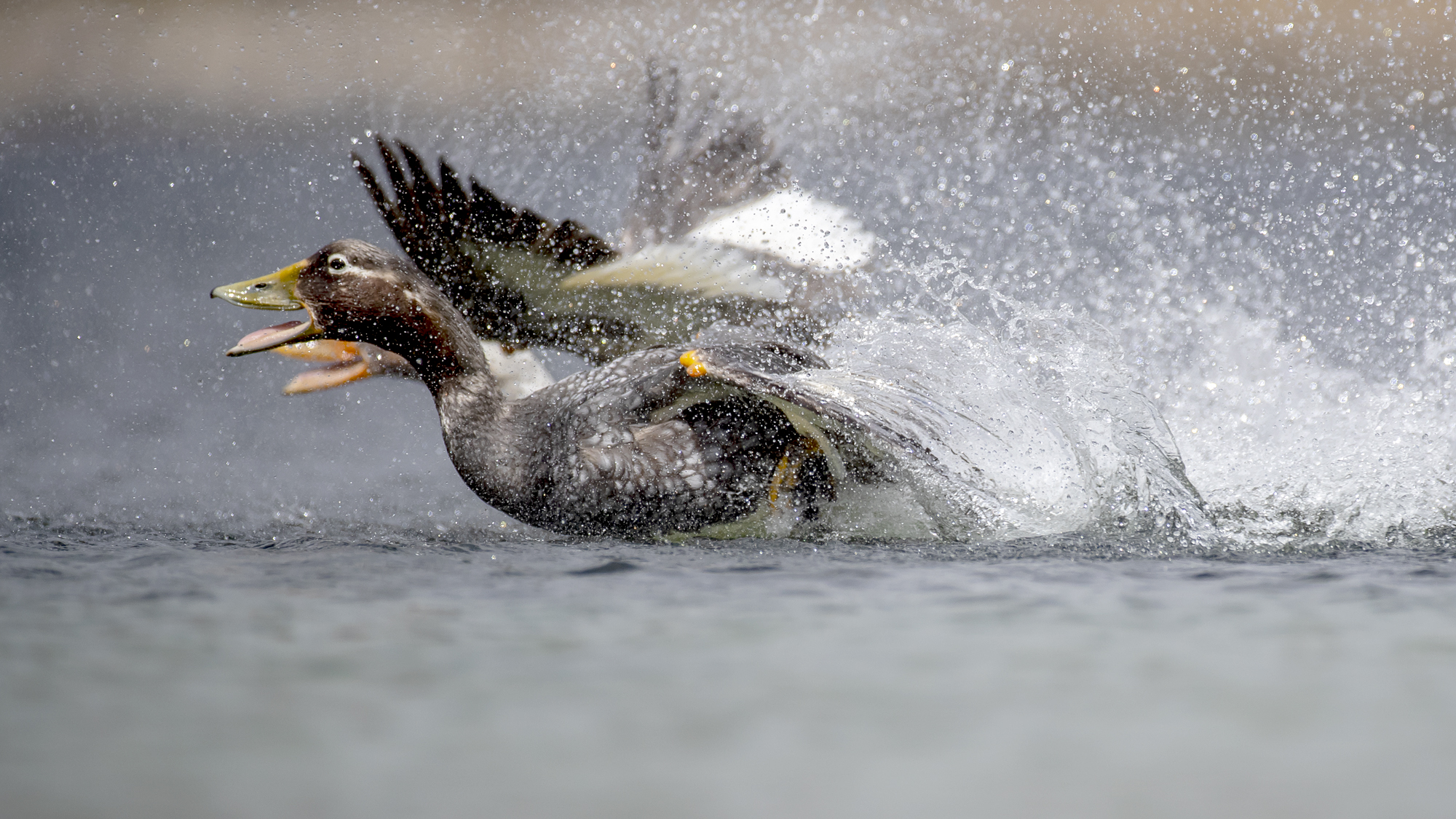
Falkland steamer ducks chasing of an intruder
We return to Port Stanley and have a very nice goodbuy dinner with drinks in the bar. A nice ending to a great trip in fantastic wilderness. The trip home is “only” two days including a night in Santiago. I really want to go back but it is very far. I think Antartica is the next long trip.
Thanks Wildphoto for a great adventure!


